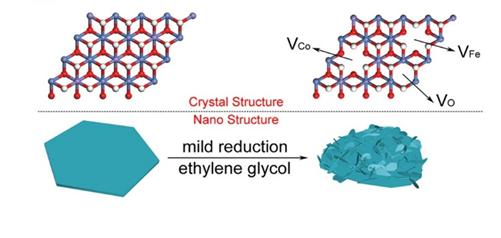
Credit: ©Science China Press
The oxygen evolution reaction (OER) with sluggish reaction kinetics and large over-potential is the severe reaction in water splitting that is promising for energy storage and conversion. However, it is still the bottleneck reaction of the water-splitting system because of the slow kinetics and large over-potential during the anodic polarization process. Therefore, it is crucial to develop highly efficient OER catalysts which can lower the over-potential effectively and accelerate reaction kinetics.
At present, CoFe double metal oxides or hydroxides have been proved by many studies to be efficient catalysts for catalyzing OER. However, the performance of the corresponding bulk catalysts is still unsatisfactory in practical applications. Based on this, it is of considerable significance to achieve the simultaneous improvement of the apparent activity and intrinsic activity of CoFe-based catalysts through material nanostructure engineering and electronic structure regulation.
Recently, Professor Shuangyin Wang’s group from Hunan University, based on the strategy of defect engineering, used a mild reducing agent-ethylene glycol as a solvent in the solvothermal reduction of bulk CoFe LDHs to achieve defects construction. Such treatment realized the formation of anion and cation defects (O, Co, and Fe), and the bulk CoFe LDHs were in situ exfoliated, and a three-dimensional hierarchical structure was formed due to the intercalation effect of large size ethylene glycol during the solvothermal process.
After further morphology and electronic structure characterization, the authors found that the defect-rich structure significantly increased the intrinsic activity of the material, and the resulted 3-dimensional hierarchical structure promoted the mass transfer in the catalytic process, ultimately achieving effective OER performance.
Besides, compared with the conventional the two-dimensional material exfoliation or defect construction methods, this method breaks through the bottleneck of scale-up exfoliation of two-dimensional material, and the exfoliation of two-dimensional catalyst and in-situ development of three-dimensional structure are realized by a simple one-step solvothermal method. It provides a new direction for the large-scale preparation and application of OER catalysts.
###
This research was funded by the Fundamental Research Funds for the Central Universities (Grant Nos. 531107051102), the National Natural Science Foundation of China (Grant No. 51402100, 21573066, and 21522305) and the Provincial Natural Science Foundation of Hunan (Grant no. 2016TP1009) and the Shenzhen Discovery Funding (JCYJ20170306141659388).
See the article: Zhou P, He J, Zou Y, Wang Y, Xie C, Chen R, Zang S, Wang S. Single-crystalline layered double hydroxides with rich defects and hierarchical structure by mild reduction for enhancing the oxygen evolution reaction. Sci. China Chem., 2019, DOI:10.1007/s11426-019-9511-x.
http://engine.
Media Contact
Shuangyin Wang
[email protected]
Related Journal Article
http://dx.



